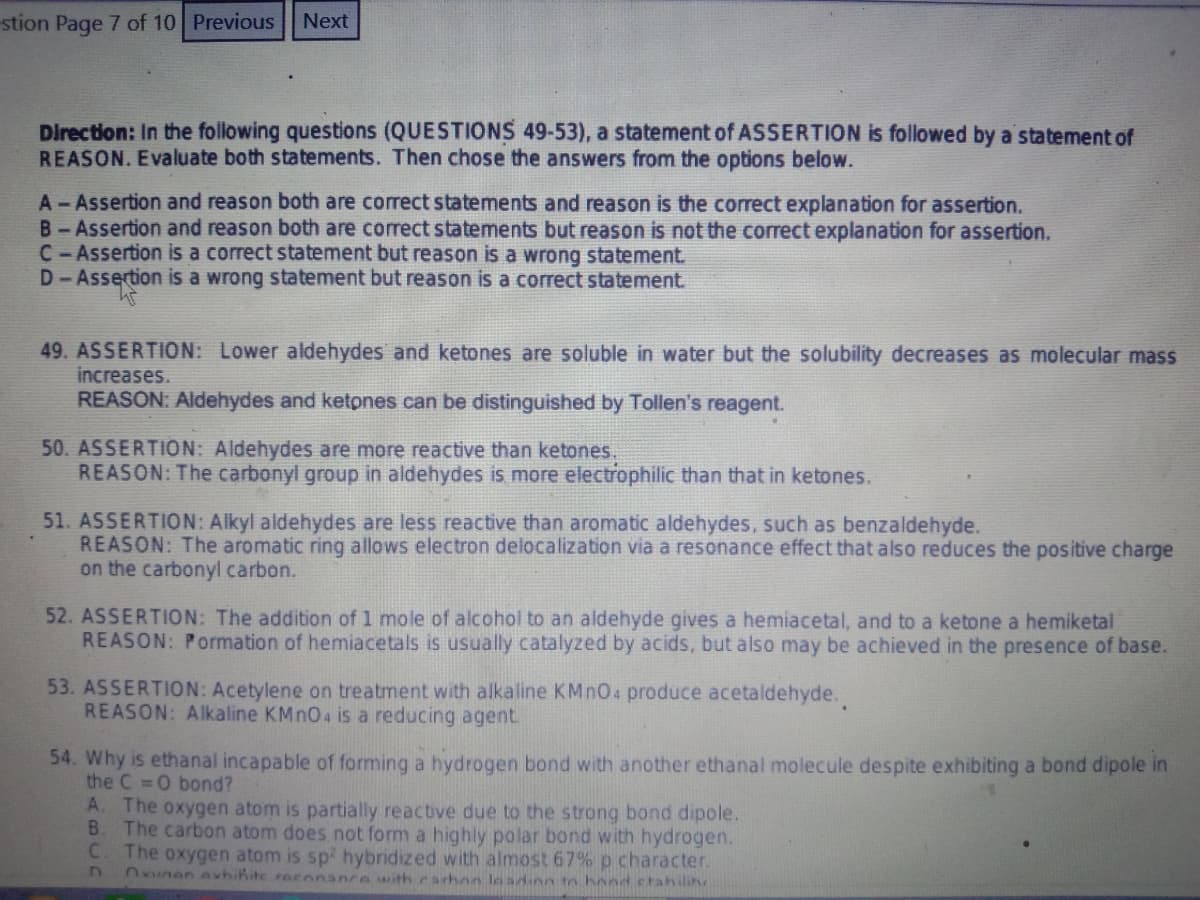Chemistry
10th Edition
ISBN:9781305957404
Author:Steven S. Zumdahl, Susan A. Zumdahl, Donald J. DeCoste
Publisher:Steven S. Zumdahl, Susan A. Zumdahl, Donald J. DeCoste
Chapter1: Chemical Foundations
Section: Chapter Questions
Problem 1RQ: Define and explain the differences between the following terms. a. law and theory b. theory and...
Related questions
Question
Answer no. 53

Transcribed Image Text:stion Page 7 of 10 Previous Next
Direction: In the following questions (QUESTIONS 49-53), a statement of ASSERTION is followed by a statement of
REASON. Evaluate both statements. Then chose the answers from the options below.
A- Assertion and reason both are correct statements and reason is the correct explanation for assertion.
B-Assertion and reason both are correct statements but reason is not the correct explanation for assertion.
C-Assertion is a correct statement but reason is a wrong statement.
D-Assertion is a wrong statement but reason is a correct statement.
49. ASSERTION: Lower aldehydes and ketones are soluble in water but the solubility decreases as molecular mass
increases.
REASON: Aldehydes and ketones can be distinguished by Tollen's reagent.
50. ASSERTION: Aldehydes are more reactive than ketones.
REASON: The carbonyl group in aldehydes is more electrophilic than that in ketones.
51. ASSERTION: Alkyl aldehydes are less reactive than aromatic aldehydes, such as benzaldehyde.
REASON: The aromatic ring allows electron delocalization via a resonance effect that also reduces the positive charge
on the carbonyl carbon.
52. ASSERTION: The addition of 1 mole of alcohol to an aldehyde gives a hemiacetal, and to a ketone a hemiketal
REASON: Pormation of hemiacetals is usually catalyzed by acids, but also may be achieved in the presence of base.
53. ASSERTION: Acetylene on treatment with alkaline KMnO4 produce acetaldehyde.
REASON: Alkaline KMnO4 is a reducing agent.
54. Why is ethanal incapable of forming a hydrogen bond with another ethanal molecule despite exhibiting a bond dipole in
the C =0 bond?
A. The oxygen atom is partially reactive due to the strong bond dipole.
B. The carbon atom does not form a highly polar bond with hydrogen.
C. The oxygen atom is sp² hybridized with almost 67% p character.
n
Ovunen avhikite raconance with rachon leading to hand stability
Expert Solution
This question has been solved!
Explore an expertly crafted, step-by-step solution for a thorough understanding of key concepts.
Step by step
Solved in 2 steps

Knowledge Booster
Learn more about
Need a deep-dive on the concept behind this application? Look no further. Learn more about this topic, chemistry and related others by exploring similar questions and additional content below.Recommended textbooks for you

Chemistry
Chemistry
ISBN:
9781305957404
Author:
Steven S. Zumdahl, Susan A. Zumdahl, Donald J. DeCoste
Publisher:
Cengage Learning

Chemistry
Chemistry
ISBN:
9781259911156
Author:
Raymond Chang Dr., Jason Overby Professor
Publisher:
McGraw-Hill Education

Principles of Instrumental Analysis
Chemistry
ISBN:
9781305577213
Author:
Douglas A. Skoog, F. James Holler, Stanley R. Crouch
Publisher:
Cengage Learning

Chemistry
Chemistry
ISBN:
9781305957404
Author:
Steven S. Zumdahl, Susan A. Zumdahl, Donald J. DeCoste
Publisher:
Cengage Learning

Chemistry
Chemistry
ISBN:
9781259911156
Author:
Raymond Chang Dr., Jason Overby Professor
Publisher:
McGraw-Hill Education

Principles of Instrumental Analysis
Chemistry
ISBN:
9781305577213
Author:
Douglas A. Skoog, F. James Holler, Stanley R. Crouch
Publisher:
Cengage Learning

Organic Chemistry
Chemistry
ISBN:
9780078021558
Author:
Janice Gorzynski Smith Dr.
Publisher:
McGraw-Hill Education

Chemistry: Principles and Reactions
Chemistry
ISBN:
9781305079373
Author:
William L. Masterton, Cecile N. Hurley
Publisher:
Cengage Learning

Elementary Principles of Chemical Processes, Bind…
Chemistry
ISBN:
9781118431221
Author:
Richard M. Felder, Ronald W. Rousseau, Lisa G. Bullard
Publisher:
WILEY